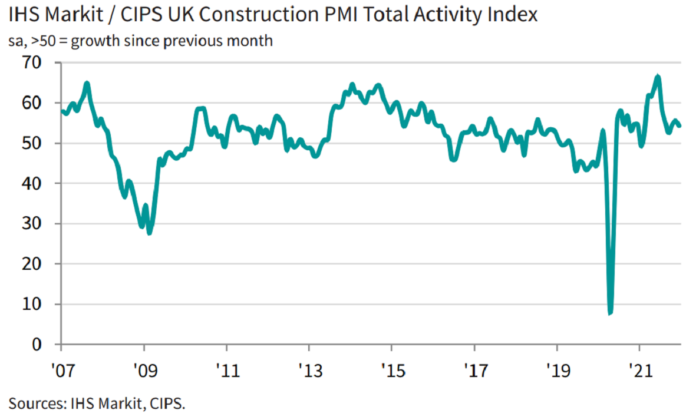The latest PMI data has pointed to another solid increase in business activity in December across the UK construction sector, but the rate of expansion slipped to its lowest since September.
However, the number of construction firms reporting supplier delays dropped from 47% in November to 34% in December, with around 5% of the survey panel reporting shorter lead times among vendors (up from 4%). The resulting index signalled the least marked downturn in supplier performance since November 2020.
The headline seasonally adjusted IHS Markit/CIPS UK Construction PMI Total Activity Index posted 54.3 in December, to remain above the crucial 50.0 no-change threshold. However, the latest reading was down from 55.5 in November and signalled the weakest rate of expansion for three months. Some survey respondents noted that tighter pandemic restrictions and rising COVID-19 cases had acted as a brake on recovery, especially in the commercial sector.
Residential construction activity saw the strongest growth (index at 55.3) and was the only category to gain momentum in December. Meanwhile, commercial building lost its position as the best performing segment, with the recovery easing to its lowest since September (index at 53.6).
Elsewhere, civil engineering activity decreased slightly at the end of 2021 (index at 49.1), which ended a nine-month period of expansion.
Customer demand was relatively resilient in December, despite some reports citing delayed decision-making due to the Omicron variant. In fact, the latest rise in overall new order volumes was the strongest since August. Higher levels of new work have now been recorded for 19 consecutive months.
Price inflation slows
Higher fuel, energy and raw material prices continued to push up average cost burdens across the construction sector in December. However, the overall rate of inflation eased for the fourth month running to its lowest since March.
An improved alignment between demand and supply helped to soften inflationary pressures at the end of 2021. Purchasing activity increased at the slowest pace for three months, while supplier lead times lengthened to the least marked extent since November 2020. Where longer wait times were reported, this was mostly linked to international shipping delays and shortages of haulage drivers.
Boosting employment numbers
A sustained rebound in construction orders helped to boost employment numbers during December. However, the rate of job creation eased only slightly since November. Survey respondents often commented on extra staff hiring as part of new project starts and long-term expansion plans.
What’s to come?
Looking ahead, just over half of the survey panel (51%) forecast a rise in business activity during 2022, while only 9% predict a decline. Although signalling upbeat sentiment for the year ahead, the degree of optimism was the joint-lowest reported since January 2021.
Industry thoughts…
Commenting on the latest data, Joe Sullivan, partner at MHA, said: “The availability of labour is now the number one issue within the UK construction sector, with wages continuing to rise. Staff mobility is high as people look for the best pay packets, causing further disruption. In addition, the spread of the Covid-19 Omicron variant has inhibited progress on building sites, dampening output and making planning even more difficult.
“However, despite these challenges, confidence in the construction sector is still quite strong. There are signs that the supply chain crisis is easing. Firms have noticed small improvements in the availability of supplies and the rate of material price increases may have peaked. Although certain decisions may be deferred until the Omicron variant abates, all indications are that plenty of work is available as we begin 2022.
“The recent 0.15% increase in the Bank of England base rate is unlikely to disturb the residential housing market, as strong demand persists, and most homeowners have fixed rate mortgages. It is the start of an attempt to curb inflation, but not an event to cause a concern to growth at present.”




